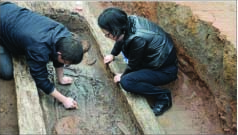
A large cluster of boat coffin tombs dating back 2,200 years was discovered at a construction site in Feihu Village, Pujiang County in southwest China’s Sichuan Province in September last year.
Pujiang County was part of the Shu Kingdom, which has no written record of its history. Chinese archaeologists said the latest discovery will help shed light on ancient indigenous culture.
The tomb cluster belonged to the indigenous Shu culture and contains elements of the Chu and Qin cultures. It covers an area of 10,000 square meters and has 60 tombs in four rows.
The tombs date back to the late Warring States Period (475-221 BC) and the Qin Dynasty (221-206 BC). The boat-shaped coffins, each four to seven meters long, are made of nanmu, a rare wood.
More than 300 pieces of pottery, bronze, iron and bamboo as well as weapons, coins and 11 seals, have been dug up, said Gong Yangmin, head of the excavation team.
Gong said two excavated tombs were well-preserved. In one, workers discovered 10 bamboo baskets of well-preserved grain and a delicate string of glass beads on the waist of the tomb owner, showing his high status.
“Glass beads like dragonfly eyes were exotic at the time. They were probably imported via the Silk Road,” said Gong.
As there are ruins of salt wells nearby, the tomb owners were possibly salt administration officials, according to archaeologists.